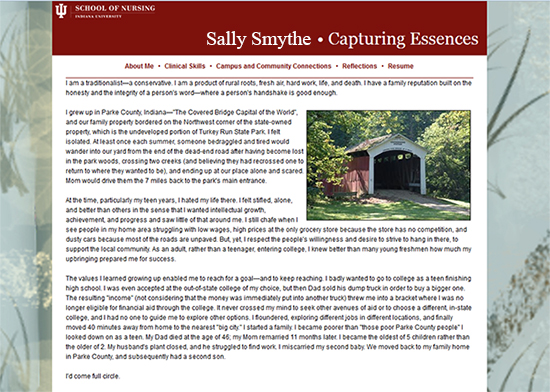Portfolios
An online portfolio (also known as electronic portfolio or eportfolio) is a collection of artifacts that learners assemble to provide evidence of specific learning ( Indiana University). They are not about the particular technology that is used to create the eportfolio, but the learning that has occurred and can be documented. In addition to documenting learning, eportfolios contribute to deep learning through the addition of reflective writing. When a learner reflects on learning that has occurred, identifies one or more artifacts that demonstrates that learning, then writes about that process holistically, deeper learner results.
Ivory Research has published one of the best resources I've seen on reflective portfolios, stating how students who reflect on their learning are able to apply theoretical knowledge as they complete assignments and explore learning processes. I encourage you to read the entire page; it won't be time wasted if you're exploring eportfolios.
 Portfolios are useful to document learning processes, showcase achievements, and evaluate programs (Education.com). Students create portfolios to demonstrate they are meeting course outcomes, making connections between theory and practice, and developing as learners and as professionals. They purposefully choose artifacts that provide evidence of these achievements; they thoughtfully organize the artifacts and supporting documentation in meaningful ways. Students creatively display the portfolios through websites or commercially available portfolio platforms.
Portfolios are useful to document learning processes, showcase achievements, and evaluate programs (Education.com). Students create portfolios to demonstrate they are meeting course outcomes, making connections between theory and practice, and developing as learners and as professionals. They purposefully choose artifacts that provide evidence of these achievements; they thoughtfully organize the artifacts and supporting documentation in meaningful ways. Students creatively display the portfolios through websites or commercially available portfolio platforms.
Many CMSs, such as Sakai and Canvas, have portfolio functionality built-in. There are also many commercial products such as TaskStream, Mahara, Chalk & Wire, and FolioTek, to name but a few. Your students have a variety of options available for building and sharing their eportfolios. As faculty, your goal is to guide the students and to assess the results.
Scaffolding
If you choose to make an eportfolio a requirement in your course, you will need to provide scaffolding to guide learners. Scaffolding are the prompts that faculty write to guide learners in their selection of artifacts and in the writing of reflections. Reflective writing is not as straightforward as many believe and students (and faculty!) need practice in thinking reflectively. Too often, we think in descriptive or factual terms. For example, the following is a descriptive observation:
| Yesterday I observed the RN as he completed a head-to-toe assessment of an 85-year-old female who presented to the ER complaining of numbness and tingling in her left arm. |
Contrast the previous with this reflection:
| I have always considered myself to be a "thinker" but working with my professors in the school of nursing has caused me to think about thinking in a different way. For example, I recently observed an RN on the clinical unit who was completing a head-to-toe assessment of an elderly woman who came to the ER complaining of numbness and tingling in her left arm. The nurse is a seasoned professional and used the talk-aloud method of explaining to me what he was considering and seeing and all the data he was processing as he was completing the assessment. I learned so much more than simply having practiced an assessment in the lab by understanding the expert reasoning that was occurring behind the routine tasks. In addition, I noted how he treated Mrs. M—he was careful to respect her as a person, to take into consideration her feelings at being in a strange place and with a male caregiver. He acknowledged her apprehensions and took the time to explain things carefully and to make sure that she felt a part of the team rather than object being cared for. I realized I have a lot to learn about treaing the whole person. I want to be the kind of healthcare professional that I observed Nurse Cailey being. I've come a long way learning the technical stuff; now I really need to work on the internal stuff. |
Assessing ePortfolios
There are different schools of thought on how—or if—to evaluate eportfolios. One school of thought is that they should not be evaluated. The rationale for this is because individual artifacts, meeting specific specific assignment criteria, have already been assessed by the faculty, the portfolio itself which is primarily composed of reflections, should not be assessed. Other viewpoints are that the construction of the portfolio—the decisions about what to include, or leave out, and how the portfolio is organized demonstrate cognitive processing and should be evaluated. Others take the view that completion of the portfolio should be noted but not assigned a score.
If you are of the thought that the portfolio should be evaluated, I recommend that you locate or develop a rubric to guide you. Mueller's Authentic Assessment Toolbox contains information on portfolios, including points of view on evaluation and links to evaluation rubrics. University of Wisconsin—Stout published an example evaluation rubric that you may use for peer or self-assessment. This page from the University of California-Berkeley has a variety of practices and resources related to e-porfoliols.
Other sites that provide example rubrics include:
